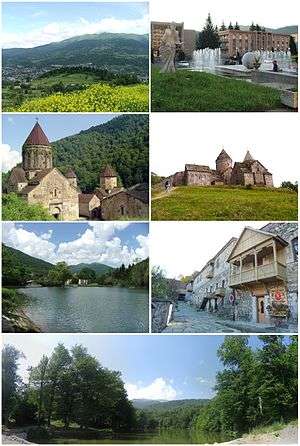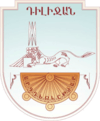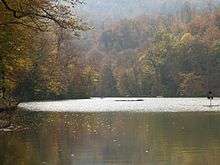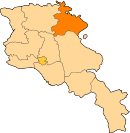Dilijan
| Dilijan Դիլիջան | ||
|---|---|---|
|
From top left: Dilijan skyline • Dilijan town hall Haghartsin Monastery • Goshavank Monastery Dilijan National Park • Sharambeyan street of old Dilijan Lake Parz | ||
| ||
 Dilijan Դիլիջան | ||
| Coordinates: 40°44′27″N 44°51′47″E / 40.74083°N 44.86306°E | ||
| Country |
| |
| Province (Marz) | Tavush | |
| Founded | 1544 | |
| Government | ||
| • Mayor | Armen Santrosyan | |
| Area | ||
| • Total | 13 km2 (5 sq mi) | |
| Elevation | 1,500 m (4,900 ft) | |
| Population (2011 census) | ||
| • Total | 17,712 | |
| • Density | 1,400/km2 (3,500/sq mi) | |
| Time zone | GMT (UTC+4) | |
| Website | Official website | |
| Sources: Population[1] | ||
Dilijan (Armenian: Դիլիջան), is a spa town in the Tavush Province of Armenia. Usually called Armenian Switzerland or Little Switzerland by the locals, it is one of the most important resorts of Armenia, situated within the Dilijan National Park. The forested and reclusive town is home to numerous Armenian artists, composers, and filmmakers and features some traditional Armenian architecture. The Sharambeyan street in the centre, has been preserved and maintained as an "old town", complete with craftsman's workshops, a gallery and a museum. Hiking, mountain biking, and picnicking are popular recreational activities.
As of the 2011 census, Dilijan has a population of 17,712, down from 23,700 reported in the 1989 census.
The Armenian government is planning to turn Dilijan into a regional financial capital, beginning with the move of much of the Central Bank's operations to Dilijan in 2013.[2]
Dilijan is currently the fastest-growing urban settlement in Armenia.[3]
Etymology
Linguist Hrachia Adjarian has mentioned an explanation about Dilijan in his "Dictionary of Armenian Proper Names" where he wrote: "Dilijan (masculine) from the Persian 'heart of the soul' form, also mentioned once as Tilijan in 1544 document. The same name applies to the settlement near the lake Sevan, also a village in the way from Ghum to Sepahan in Iran".
In an ancient popular legend, the name of the town is named after a shepherd called Dili. The shepherd Dili was in love with his master's daughter, however her father was against it and ordered to kill the shepherd. For many long and dark days, the sorrowful mother was mourning and looking for her only son all over the area and desperately crying, "Dili jan, Dili jan .. " ("Jan is a Persian endearment term added to the name of a friend or family member). According to the legend the area was later known for his name.
History
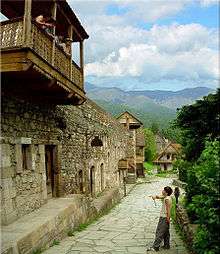
During the excavations conducted in the 1870s, many valuable items were found, dateing back to the Late Bronze and the Early Iron Ages (the end of 2000 BC-the beginning of 1000). Some of the excavated collections were transferred to the museums of Moscow, Saint Petersburg, Tbilisi, Baku and Yerevan, while the reminder was kept in the Dilijan Geological Museum.
During the medieval period, the territory of Dilijan was known as Hovk. Hovk was a favourite forest and a summer resort for the Arsacid kings to show their abilities in hunting. The settlement of Bujur Dili was founded during the 13th century near the area of modern-day Dilijan. The monasteries of Haghartsin and Goshavank were built between the 10th and 13th centuries. The monastery complexes have quickly developed and have served as cultural and educational centers. Haghartsin is one of the iconic examples of the developing Armenian architecture during the Middle Ages. Many other important religious and educational centers of the Middle Ages have survived in Dilijan, such as the Jukhtak Vank Monastery and Matosavank Monastery.
In 1666, the name Dilijan was mentioned for the first time in the notes of the French traveler Jean Chardin. Since the town became under the Russian rule in 1801, the population had gradually grown. In 1868 the first public education school was opened in Dilijan.
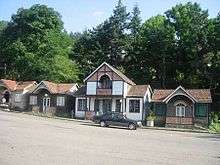
Auspicious conditions for cultural development have appeared at the end of the 19th and in the beginning of the 20th centuries. Many theatre groups were organized during the 1890s and the first library of the town was opened in 1908.
In the second half of the 19th century, Dilijan became a well-known mountain resort the town began to grow gradually. By the end of the 19th century, many entertaining centres were opened in the town, and the famous open-air theatre -known as Rotonda- was built in 1900. The theatre became a favorite place for locals and the visiting Russian intellectuals.
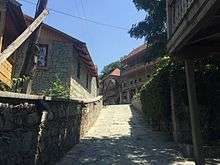
At that period, many modern houses were constructed in a unique traditional architectural style. Many wealthy Armenians from Tiflis and other areas of Transcaucasia began to build their own villas in Dilijan. The architecture in Dilijan has been characterized with gable tiled roof, wide patterned oriel and whitewashed walls. The style has quickly been spread all over the villages at the Aghstev river valley.
At the beginning of the 20th century, many traditional crafts have been developed in Dilijan including metalsmith, carpet weaving, fine arts, wood engraving and other types of folk crafts.
Geography
.jpg)
Dilijan lies on the banks of Aghstev River with a length of more than 20 kilometres (12 miles) and at a height of 1,500 metres (4,921 feet) above sea level. The valley is surrounded with the Lesser Caucasus mountains from the north, and the Semyonovka mountain pass from the south. The mountainous areas are all covered with thick forests occupying a territory of more than 34,000 hectares (84,016 acres). Reaching up the highest peaks of the mountains, the forests turn into Alpine meadows. In addition to Aghstev River, many other tributaries flow through the town.
Climate
The climate in Dilijan is cool during summer and cold with snowfalls in winter. With its Alpine climate, Dilijan is a town-resort with favorable oxygen regimen, unique landscape features and curative mineral water.
| Climate data for Dilijan | |||||||||||||
|---|---|---|---|---|---|---|---|---|---|---|---|---|---|
| Month | Jan | Feb | Mar | Apr | May | Jun | Jul | Aug | Sep | Oct | Nov | Dec | Year |
| Average high °C (°F) | 4.2 (39.6) |
5.0 (41) |
8.2 (46.8) |
14.5 (58.1) |
18.9 (66) |
21.6 (70.9) |
24.4 (75.9) |
24.3 (75.7) |
20.8 (69.4) |
16.4 (61.5) |
10.7 (51.3) |
6.3 (43.3) |
14.6 (58.3) |
| Average low °C (°F) | −6.2 (20.8) |
−5.5 (22.1) |
−2.9 (26.8) |
2.3 (36.1) |
6.5 (43.7) |
9.3 (48.7) |
12.7 (54.9) |
12.3 (54.1) |
9.0 (48.2) |
3.9 (39) |
0.0 (32) |
−3.9 (25) |
3.1 (37.6) |
| Average rainfall mm (inches) | 22 (0.87) |
30 (1.18) |
45 (1.77) |
65 (2.56) |
106 (4.17) |
103 (4.06) |
66 (2.6) |
51 (2.01) |
46 (1.81) |
47 (1.85) |
36 (1.42) |
22 (0.87) |
639 (25.16) |
| Average rainy days | 7 | 8 | 12 | 14 | 16 | 14 | 9 | 7 | 9 | 10 | 9 | 6 | 121 |
| Source: World Meteorological Organization[4] | |||||||||||||
Dilijan National Park
The forests of Dilijan cover an area of more than 34,000 hectares. For the enrichment of the natural life around Dilijan, the state forest reserve was founded in 1958 to become known as Dilijan National Park later in 2002. Woods cover 94% of the park territory and with around 40 types of trees and 18 types of bushes, being mostly oaks, beeches, hornbeams, maples, elms, willows, etc.
The national park is also rich in its fauna, including brown bear, wolf, marten, otter, lynx, sylvan cat, Persian squirrel, sylvan dormouse, hedgehog, chamois, European red deer, wild hog, pheasant, quail, partridge, Caspian turkey, culver, bald eagle, lammergeyer, pygmy eagles, golden eagle, hawk and others.
Lake Parz is one of Dilijan's most attractive natural sites. It is situated in the northern part of the town at a height of 1,400 metres (4,593 feet) above sea level. It has an area of 2 hectares (5 acres) and an average depth of 8 metres (26 feet).
To the east of the Lake Parz, at a distance of 3 kilometres (2 miles) from Gosh village, Lake Tzlka is located at a height of 1,500 metres (4,921 feet). Aghstev River with its tributaries passes through the town and the surrounding forest. Its origins are from the northwestern part of the Pambak mountain range, at a height of 2,980 metres (9,777 feet). Aghstev River has a length of 133 kilometres (83 miles). Many tributaries flow into Aghstev such as Bldsan, Ghshtoghan, Haghartsin and Getik rivers.
Demographics

The majority of the population in Dilijan are ethnic Armenians who belong to the Armenian Apostolic Church. They belong to the Diocese of Tavush of the Armenian Apostolic Church based in Ijevan.
Here is the population timeline of Dilijan since 1976:
| Year | 1976 | 1989 | 2001 | 2011 | 2016 |
|---|---|---|---|---|---|
| Population | 24,056 | 30,433 | 16,202 | 17,712 | 17,600 |
Culture
Dilijan has a rich historical and cultural heritage. During the nearby excavations in the prehistoric cemeteries of Golovino and Papanino, bronze items of almost three thousand years old were found, including armours, daggers, pitchers, ear-rings and others were found. All those items could be found either in the Dilijan museum or in the Hermitage Museum.
In 1932 the State Theatre was founded in Dilijan under the supervision of the honored USSR artist Hovhannes Sharambeyan, while the school of music was founded in 1946.
On 26 January 2013, the American University of Armenia and the Central Bank of Armenia inaugurated a new state-of-the-art library at the Knowledge for Development Center in Dilijan.[5] On the same day, the Dilijan branch of Tumo Center for Creative Technologies was also opened in the development center.[6]
Monuments
- Dilijan museum of traditional art: originally a residential house dating back to the second half of the 19th century, turned into traditional art museum in 1979.
- The open-air theatre, also known as the Rotonda: built in 1900, it is located at the centre of the town. Many prominent artist performed in the theatre including H. Abelian, Vahram Papazian, A. Hrachian and others.
- Dilijan museum of geology: opened in 1952, it is located at the centre of the town.
- Memorial to Soviet Armenia: built in 1970 by the artists A. Tarkhanyan, S. Avetisyan, K. Vatinyan, symbolizing the 50th anniversary of the Sovietization of Armenia. Five edges of the monument symbolize each decade of the 50 years.
- Memorial to the World War II: built near central park in 1975 by K. Vatinyan and S. Mehrabyan to commemorate the local martyrs during the World War II.
Nearby attractions
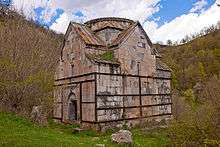
.jpg)
- Haghartsin Monastery: one of Armenia's most popular monasteries, Haghartsin is nestled in lush forested mountains about a half-hour drive from Dilijan. The monastery is in good condition and has a resident priest who sometimes gives tours. There are a few different churches, a large gavit, a huge dining hall, khachkars and a massive hollow tree. A slightly sweet bread is often being baked in an old oven.
- Goshavank Monastery: located to the north of the town, surrounded with a traditional village, and has a groundskeeper who opens the main church building up for visitors, and can give a tour. This is the one church in all of Armenia where entrance to one of the chambers is not free. The chamber is nice, but you can certainly enjoy the rest of the complex without it, especially since it may not be offered in English. There are excellent carved details and khachkars here, but the "lacework" khachkar at Goshavank is one of the most impressive in the world.
- Jukhtak Vank Monastery: small 12th century monastery located just at the edge of Dilijan, only at a 10-minute hike from the Dilijan Mineral Water plant. Huge iron bands hold one of the two churches together, preventing its It has two separate churches, Surp Astvatsatsin and Surp Grigor with their surrounding cemeteries.
- Matosavank Monastery: located in the forest opposite to Jukhtak Monastery. It is easy to miss, and not terribly interesting from the outside, but the inside is a cool, moist, green, mossy world unto itself. The low light illuminating bright green algae covered khachkars is very soothing, and the environment transports you far from your daily life.
- Dilijan National Park: or the Dilijan Reserve, occupying 24,000 hectares, is well known for its forest landscapes, rich biodiversity, medicinal mineral water springs, natural and cultural monuments.
- Other historic monasteries: Saint Gregory of the 10th century, Saint Stepanos and Saint Astvatsatsin of to the 13th century with a number of khachkars in the complex.
Transportation
Dilijan is connected with Yerevan and central Armenia through the M-4 Motorway. The town is an important connecting point between the capital Yerevan and northeastern Armenia reaching up the border with Azerbaijan.
The 2.25 km-long Dilijan tunnel is part of the M-4 Motorway.
The town has a railway station since the 19th century.
Economy
Industry
Dilijan is famous for its mineral water, being processed and bottled by the "Dilijan Mineral Water Plant" founded in 1947. The town is also home to the "Aramara" company for fine woodworking founded in 1993,[7] and the "Dili" factory for dairy products founded in 2005.
Dilijan is also famous for its hand-made rugs and carpets. The town has its own style of carpet design, with many samples shown at the Dilijan museum of traditional art.
Tourism
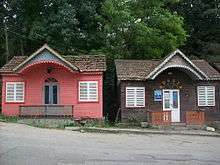
In 2009, it was announced by the Armenian government that Dilijan will turn into a developed financial centre for Armenia and the region. According to government officials, many of the operations and responsibilities of the Central Bank of Armenia will move the northern town-resort of Dilijan, starting from 2013.
Currently, many significant financial and cultural institutions are operating in the town such as the Dilijan regional financial and banking centre, the United World College Dilijan, the Old Dilijan-Tufenkian Centre, the modern building of Dilijan theatre and the Dilijan Museum.
Dilijan is among the favorite destinations for local and foreign tourists. The town has a number of high-class hotels and sanatoriums, allowing the visitors the chance to enjoy the beauty of the National Park as well as the historical sites.
The town is also famous for its mineral curing water fountains.
The central amphitheatre of Dilijan is the venue of many summer festivals and cultural events.
Education
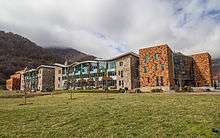
As of 2009, Dilijan had 5 public education schools and 6 kindergartens with 2250 students and 350 children respectively. A music academy and another one for arts are also operating in the town.
Dilijan has an operating branch of the Yerevan State Academy of Fine Arts. Three intermediate colleges for medicine, arts and crafts are also operating in the town.
With a cost of US$80 million, the Central Bank of Armenia's Educational Center was opened in Dilijan in 2013. Around 150 employees of the Central Bank moved from Yerevan to Dilijan along with their families on the step towards the transformation of the town into a regional financial center.[8]
In 2014, the United World College Dilijan, a part of the global educational movement United World Colleges, was opened in the town.[9]
The construction of the Dilijan Central School was launched in 2013 by the Ayb Educational Foundation with the cooperation of the Central Bank of Armenia.[10] In fall 2015, the newly built state-of-the-art school was officially opened.[11]
Sport
Dilijan has an all-seater municipal stadium with a capacity of 2,200 spectators. The Dilijan City Stadium was the home venue of the former Armenian Premier League club Impulse FC.
Impulse FC Dilijan founded in 1985, represented the town in the domestic football competitions. However, like many other Armenian football team, the club was dissolved in 2013 due to financial difficulties.
International relations
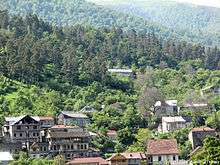
Twin towns – Sister cities
Dilijan is twinned with:
|
Famous natives
- Serik Davtian: was a famous Armenian needlework and carpet art expert, founder of the Dilijan library.
- Gagik Davtian: was a professor-scientist and academician who pioneered the hydroponics.
- Arshavir Torosian: was a professor-doctor and expert in medicinal plants of Armenia.
- Ashot Petrosian: was a mathematician, one of the founders of cybernetics and computer science in Armenia
References
- ↑ http://armstat.am/file/doc/99484283.pdf
- ↑ "Armenia To Move Central Back Out Of Capital". HULIQ.
- ↑ Dilijan central school is open
- ↑ "World Weather Information Service – Dilijan". World Meteorological Organization. Retrieved 24 September 2016.
- ↑ AUA and Central Bank Inaugurate State-of-the-Art Library at Dilijan’s Knowledge Development Center
- ↑ Tumo Expands to Dilijan
- ↑ http://www.aramara.am/?laid=1&com=module&module=menu&id=3 Aramara fine woodworking]
- ↑ Construction of financial center in Dilijan to be completed in 2013
- ↑ "UWCD - Home". dilijanschool.org.
- ↑ Dilijan Central School
- ↑ Dilijan Central School officially opens
External links
| Wikivoyage has a travel guide for Dilijan. |
| Wikimedia Commons has media related to Dilijan. |
Coordinates: 40°44′27″N 44°51′47″E / 40.74083°N 44.86306°E
